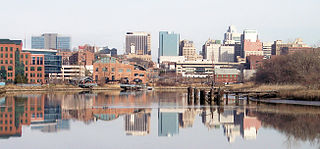
New Castle is a city in New Castle County, Delaware, six miles (10 km) south of Wilmington, situated on the Delaware River. According to the 2010 Census, the population of the city is 5,285.

Lombardy Hall is a historic house at 1611 Concord Pike in Fairfax, Delaware. Probably built about 1750, this stone house is notable as the home of Gunning Bedford, Jr. (1747-1812), a delegate to the Constitutional Convention and a signer of the U. S. Constitution. It was declared a National Historic Landmark in 1974.

The Delaware Historical Society began in 1864 as an effort to preserve documents from the Civil War. Since then, it has expanded into a statewide historical institution with several venues and a major museum in Wilmington and the historic Read House & Gardens in New Castle.

Old Town Hall is a historic town hall located at Wilmington, New Castle County, Delaware. It was built in 1798, and is a large two-story brick building in a late-Georgian / early-Federal style. The roof is gently sloping and is topped by a large octagonal cupola and once had a wooden balustrade. The building housed the Wilmington city government until 1916 and served as a focal point of many public events in Delawares history. The property is owned and managed by the Delaware Historical Society

St. Georges Presbyterian Church is a historic Presbyterian church located on Main Street in St. Georges, New Castle County, Delaware. It was built in 1844, and is a one-story, brick, temple form, Greek Revival style building with a frame steeple. The main block measures 43 feet, 6 inches wide by 77 feet, 8 inches long, and sits on an uncoursed fieldstone foundation. The roof is supported by a Town lattice truss.
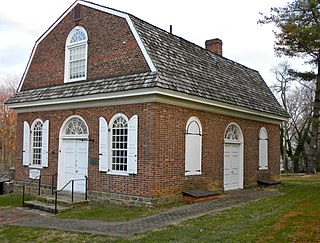
Old First Presbyterian Church of Wilmington is a historic Presbyterian church located on West Street on Brandywine Park Drive in Wilmington, New Castle County, Delaware.

Friends Meetinghouse is a historic Quaker meeting house at 4th and West Streets in Wilmington, Delaware in the Quaker Hill neighborhood. The meeting is still active with a membership of about 400 and is part of the Philadelphia Yearly Meeting. It was built in 1815–1817 and added to the National Register of Historic Places in 1976.
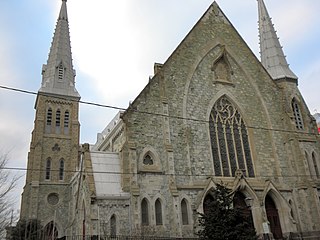
Grace United Methodist Church is a historic Methodist church located at 9th and West Streets in Wilmington, New Castle County, Delaware. It was designed by architect Thomas Dixon and built in 1868. It is constructed of serpentine stone of a light pea green color in the Victorian Gothic style. The church building measures approximately 166 feet by 102 feet, 6 inches. It features a needle spire that rises to 186 feet and is topped by a Celtic cross.
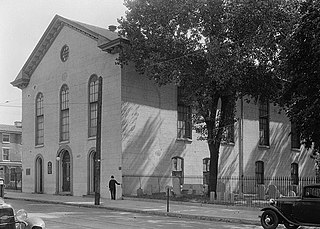
Old Asbury Methodist Church is a historic Methodist church located at Walnut and 3rd Streets in Wilmington, New Castle County, Delaware. It was the first Methodist church in Wilmington. The church is a two-story, three bay, "L"-shaped stuccoed stone structure in a vernacular Italianate style. The original section was built in 1789, and subsequently enlarged in 1820, 1825, 1838, and 1845. The chapel wing to the north was added in 1875.
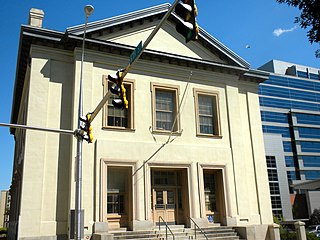
The Old Customshouse is a historic government building at 516 North King Street in Wilmington, Delaware. It was built in 1855 and added to the National Register of Historic Places in 1974.

Coffee Run Mission Site, also known as Coffee Run Church and St. Mary's Church, is a historic mission church site and national historic district located at Hockessin, New Castle County, Delaware. It encompasses two contributing buildings, both now demolished, and one contributing site. They were the Father Kenney House and stone barn with frame addition. The house was built in 1812, and was a two-story, three bay stone dwelling with a cross-gable roof. The Coffee Run cemetery is the burial ground of the first Catholic church in Delaware. It measures approximately 66 feet by 183 feet and includes over 50 carved headstones and 12 uncut stone markers. Located at the cemetery is a small cinder block building, which contains an altar, and stands at the site of the original log mission church built about 1790. It was the first Catholic church in Delaware out of which grew the present Roman Catholic Diocese of Wilmington. The house was demolished in March 2010 following an arson. The barn, also affected by arson, remained mostly intact but in a decaying condition. Trinity Community Church planned to restore it and incorporate it into a new church on the site, but discovered that the mortar was no longer sound. The barn was demolished in 2016 and the stone saved for reuse in the facade of the new church.

Swanwyck is a historic home located near New Castle in New Castle County, Delaware. It was built between 1813 and 1819, and is a two-story, three bay, stuccoed brick dwelling reflective of the Regency period. The house has been modified by later additions and is now surrounded by 20th century residential development, unlike its original farmland setting.

Main Office of the New Castle Leather Company, also known as The Main Office of the Allied Kid Company from 1933 to 1977, is a historic office building located at Wilmington, New Castle County, Delaware. It was built in 1917, and is a three-story, steel frame stuccoed brick building in the Mission Revival Style. The building measures 68 feet wide and 30 feet deep. It features a revolving door and curved granite steps at the main entrance, red Mission style tiles on the mansard, and large decorative iron bars and grill work on the first floor windows.

Starr House, also known as the Michael VanKirk House, is a historic home located at Wilmington, New Castle County, Delaware. It was built between 1801 and 1806, and is 2 1/2-story, brick dwelling with a gable roof. The house was restored in 1946 and considered the last example of colonial architecture in the city of Wilmington. Adjacent to the house is a mid-19th century frame summer kitchen, which contains a beehive oven, has been encased in brick.

Zachariah Ferris House is a historic home located at Wilmington, New Castle County, Delaware. It was built between 1718 and 1749, and was an example of an early farmhouse continually occupied by professional and working families. It is a two-story, brick dwelling measuring 29 feet wide and 18 feet deep with a gable roof. It features a panel of brickwork between the two windows of the second floor, where two rows of numerals and letters are built in with dark glazed headers. The house was owned by Congressman Louis McLane and U.S. Senator Outerbridge Horsey.
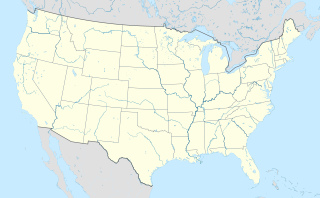
Louviers, also known as Upper Louviers and Black Gates, was a historic home located at Wilmington in New Castle County, Delaware.

Walker's Mill and Walker's Bank, also known as Simsville, Siddall's Mill, and "Big White Mill", is a historic spinning cotton mill and worker's dwelling block located near Wilmington, New Castle County, Delaware. Walker's Mill was built between 1813 and 1815, and is a 2 1/2-story, "T"-shaped, stone building. It measures approximately 100 feet by 225 feet and features a tower topped by a cupola. Walker's Bank is a two- to three-story rectangular stone building built in 1813 and consisting of four worker's homes. It measures 44 feet by 75 feet and each long side features a porch divided among the four units.

Glynrich is the site for two historic homes: the Richard Richardson House and the Brick Mill House. They are located at Wilmington, New Castle County, Delaware. The Brick Mill House, also known as the John Richardson House, was built about 1723, and is a two-story, three-bay, gable roof brick structure with Flemish bond and glazed headers on the facade rising from a full raised basement. It has a one-bay, hipped roof, wooden entrance porch. The Richard Richardson House was built in 1765, and is a two-story five-bay, center-hall, double pile with a lower single pile two-story wing at the east end. It is in the Georgian style. It has a five-bay, hipped roof Georgian Revival porch added around 1900. The property was the site of extensive milling activities on the Mill Creek in the 18th and 19th centuries.

Breck's Mill Area, also known as Breck's Mill Area-Henry Clay Village Historic District, is a national historic district located along Brandywine Creek at Wilmington, New Castle County, Delaware. It encompasses 56 contributing buildings, five contributing sites, and three contributing structures. The district encompasses The Mill, The Workers' houses, and The Mill Owner's Home.
